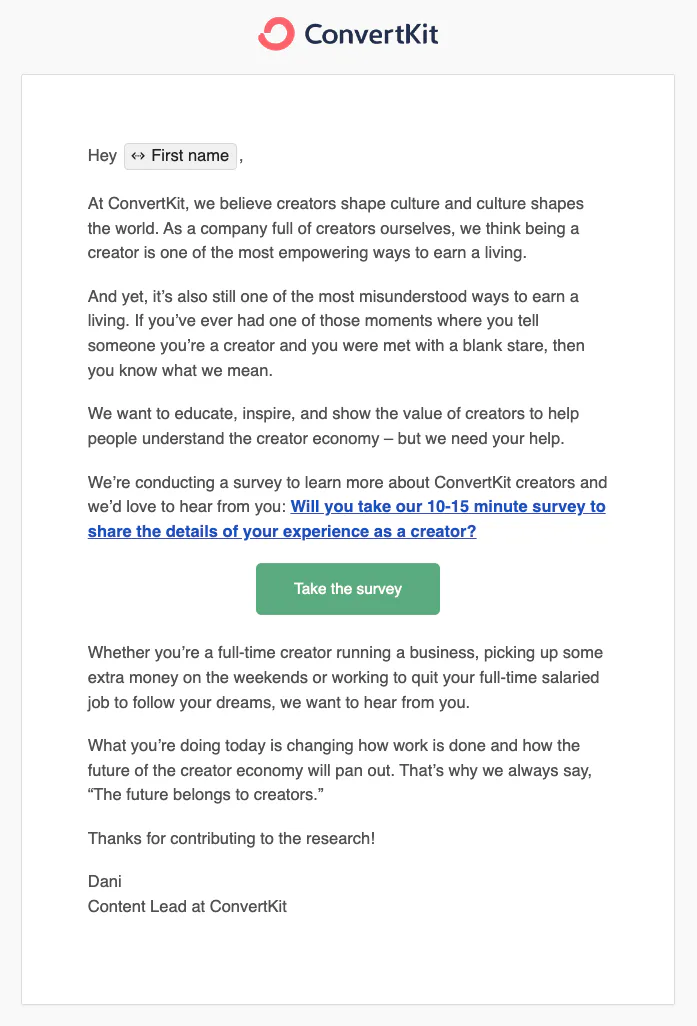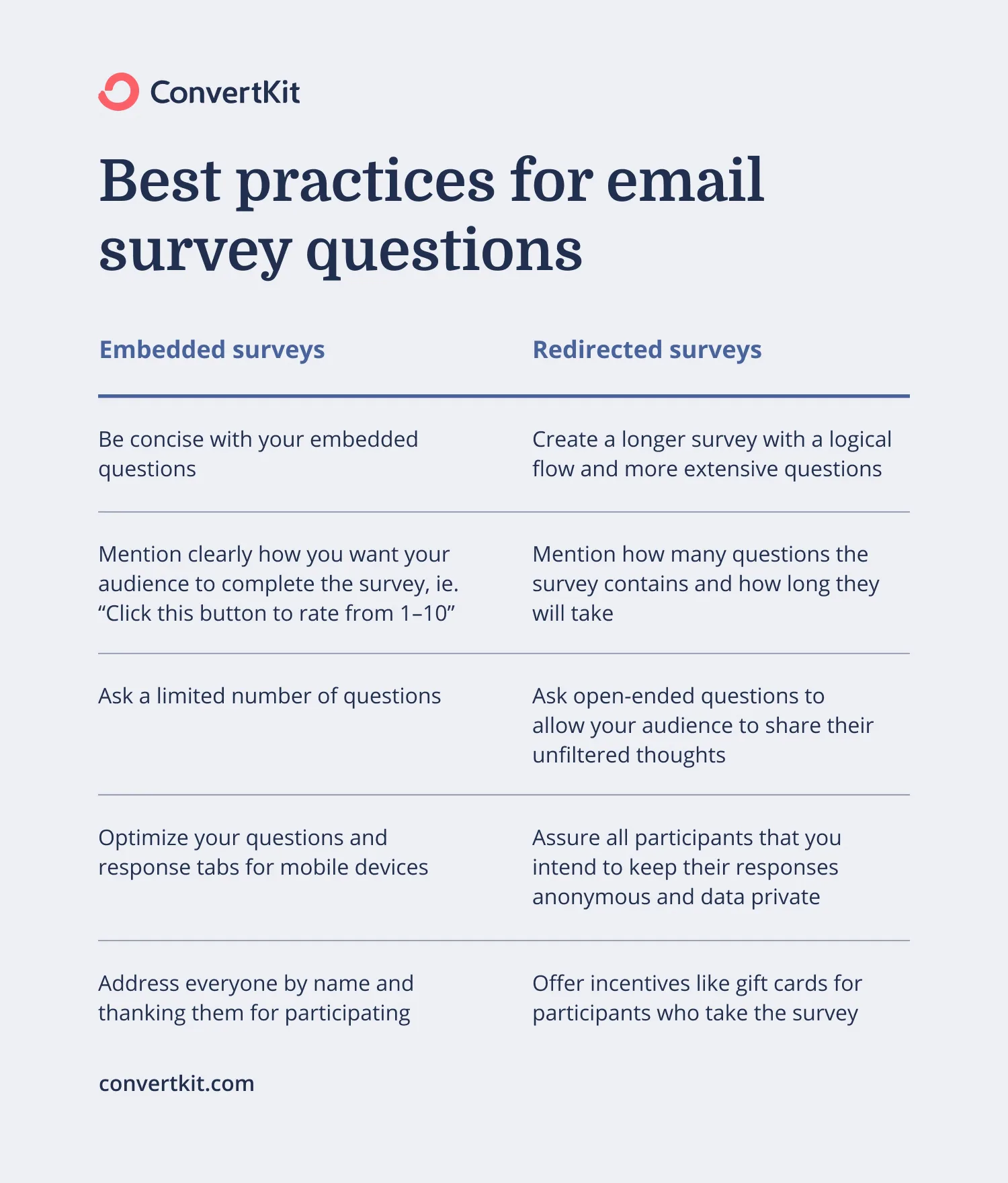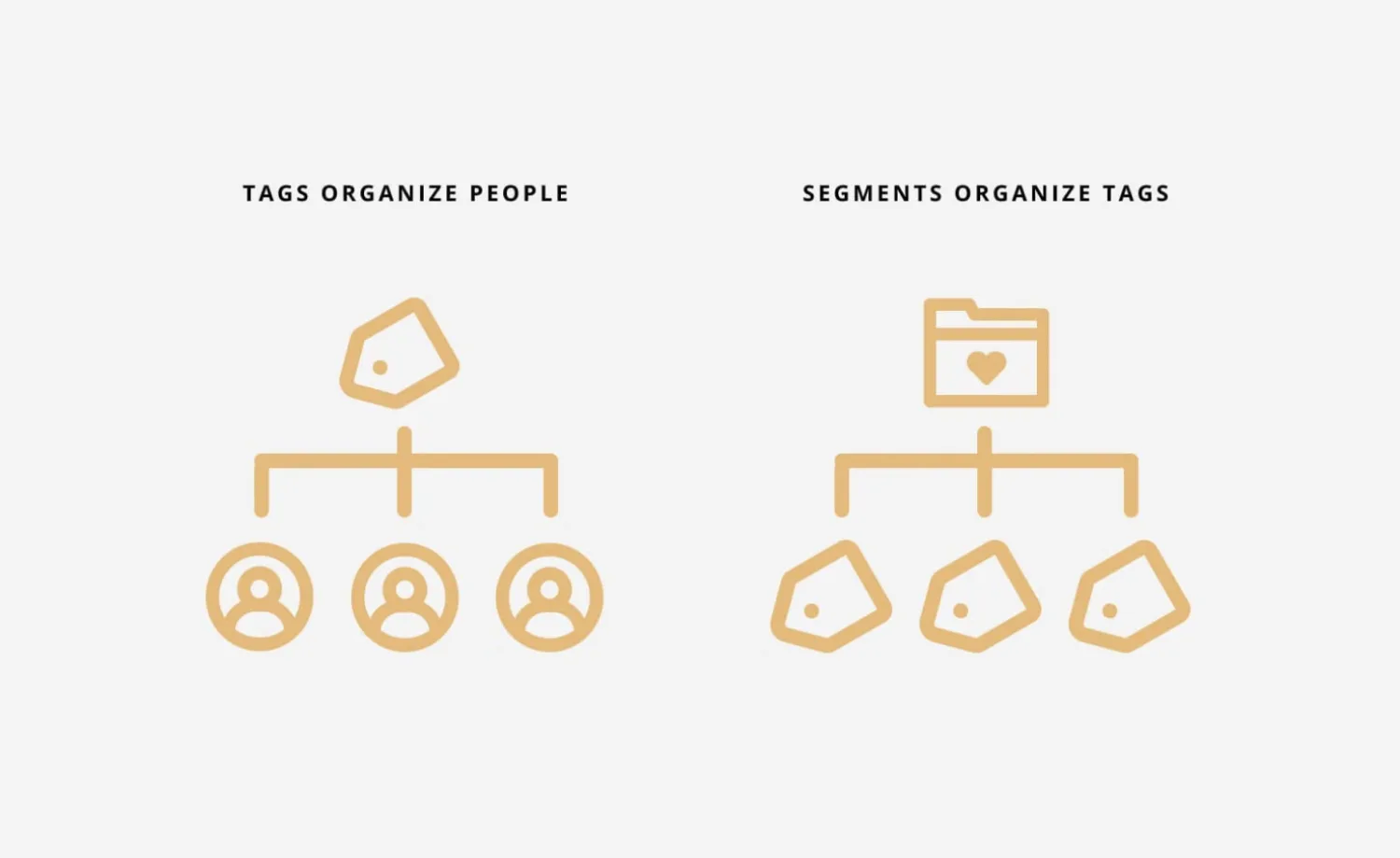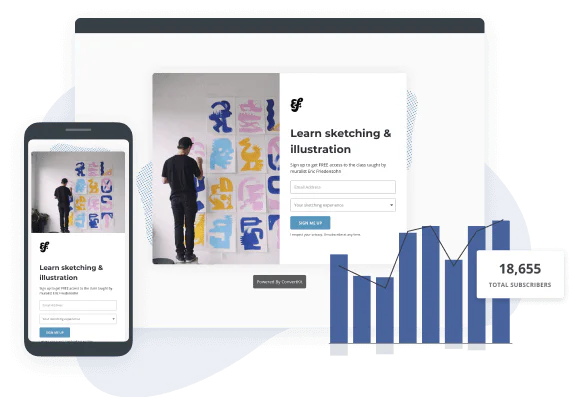In this Article
Email surveys help creators gather feedback and learn more about their audience.
They’re convenient for respondents, fast to set up, and you can use the data to inform your creator strategy.
In this guide, we’ll walk you through email surveys, their pros and cons, share seven types of surveys, and ideas on how to use them to grow your audience and income.
What are email surveys?
Email surveys involve directly sending questionnaires or surveys to your subscribers to gather quantitative data, which you can use to create or refine your existing creator marketing strategy.
For example, customers can rate a new product launch or share feedback on their latest purchase, and you use this data to understand how your launch or campaign resonates, then use these insights for next time.
The best part?
Automation makes it butter-smooth for you to create questions, send them to your audience, and collect answers hassle-free, along with neat organization and analysis.
Creating your first email poll can feel like a big task, but it’s worth the effort. Here’s what to expect:
Benefits of email surveys
- They save you time: Email surveys are easily automated so you can set and forget them. You don’t need coding skills, and the responses get tallied automatically to save you trouble and minimize the risk of error.
- They’re cost-efficient: Email surveys have limited overheads since the responses are collected and collated automatically using software.
- They have a high response rate: Email is a way for you to communicate 1:1 with your audience, so sharing a survey via email gives you the best chance at collecting many more responses from an engaged audience than other communication channels like social media.
- They’re easy to distribute: Automate email surveys to customer segments based on specific actions, such as purchasing, abandoning cart, or signing up for a promotion.
The drawback of email surveys
- They have limited reach: Email surveys need an active list of subscribers to your newsletter, so this data collection method doesn’t work unless you have the email addresses of your target audience.
- They answer quantitative questions: Email surveys can only cover limited questions, like rating a product or choosing one of the options in a multiple-choice. They’re not as effective for qualitative data collection.
- They require email marketing know-how: You need to be able to ask the right questions and offer the right choices to get answers that will add value to you, which requires email marketing know-how alongside trial-and-error.
Survey email types and 7 examples of how to use them
Type #1: Embedded email surveys
An embedded email survey (sometimes known as an email inline survey) is embedded into the body of an email and allows the recipient to answer questions directly in the email content.
This type of email survey is short, to the point, and engages audiences thanks to its snappy format.
With a tool like Kit, you don’t need to know any HTML code to engage your audience and collect high-quality response data directly from your emails.
Once you know what questions to ask, you can simply add link triggers to each answer option and automate the process so your audience can respond from within the email body easily. To learn how to create and add link triggers to your email:
- Click on Automate > Rules and select +New Rule.

- Under Trigger, select the Clicks a Link option and give your link a name and URL. Then choose the action it triggers.
- You can select Add Tag as the action so each subscriber choosing a specific survey response can be assigned a tag that you can later refer to gauge interest.
- Click on Save Rule.

- Navigate to the email in which you want to add a link trigger. Select the text, click on the link icon and instead of adding the URL, choose the link trigger option.
- Choose the name of your link trigger and click on Apply.

Now you’re all set to collecting survey responses directly from within your email.
1. Stay informed on new subscriber goals
The best way to know how to keep new subscribers engaged is to understand their goals and how you can help them.
A welcome sequence accompanied by an embedded email survey helps clarify audience challenges so you can segment readers and share relevant, personalized content alongside your products and services.
Embed this survey in your welcome email to new subscribers to:
- Get fresh content ideas
- Research on your next online course
- Get insight into the pain points you can target
- Pinpoint the goal you can help them achieve
Survey email example by James Clear
Why this works
- Evokes a feeling of excitement for future emails
- Sets the stage for what the subscribers can expect
- Enables segmentation of new subscribers based on their interests
- Provides ideas to create better-targeted content
2. Measure interest in a new niche
Email surveying your audience helps you understand whether there’s enough demand to create content for a niche audience or a new topic.
Send this type of survey by email when you want to:
- Launch a new book
- Validate your next online course
- Gauge demand for a potential service
Survey email example by Gemma Bonham-Carter
Why this works
- Single question in a yes/no format increases the likelihood of a response
- The value she offers is mentioned clearly
- You can “raise your hand” to respond with one click
- Allows easy segmentation for promotions
3. Learn why they didn’t buy
Irrespective of how good your product launch email is, the harsh truth is that not everyone will buy your products.
Instead of leaving yourself in the dark, a simple embedded survey can help you gain clarity on the top reasons why they didn’t choose to invest in your offering.
This feedback can be valuable in helping you iterate your product and course of action so your next launch is even better.
Send this type of email survey when you want to:
- Identify common obstacles
- Explore potential solutions to make your offer more attractive
- Litmus-test your audience’s confidence in your brand
Survey email example by Ryan Baustert
Why this works
- Expresses gratitude to the audience, helping build trust
- Encourages the audience to give feedback for better value-add
- One-click response to survey
4. Discover your audience’s preferred channels
As a creator, you likely create content for multiple communication channels in more than one format. Whether you choose to have an Instagram account, a Pinterest page, or a YouTube channel, it’s key to know where most of your loyal readership migrates from.
Since email newsletters tend to have active subscribers, it’s a good idea to survey them and find their preferred channels.
Send this type of email survey when you want to:
- Double down on one platform for maximum impact.
- Strengthen your relationship by meeting your audience’s needs.
- Improve engagement for a better ROI and faster growth.
Survey email example by David Perell
Why this works
- Collects audience’s preferred channels passively with well-placed anchor texts
- Simple prompts like “click here” encourage quick action
- Subtly promotes the YouTube channel to nudge a click-through
Type #2: Redirected email surveys
Redirected email surveys include a link for the recipient to click that takes them to the survey content.
Use a redirected email survey when you either have a longer survey you want your audience to participate in, or you want to ask open-ended questions. Both these formats can’t be embedded within the email body, so a redirected survey link is a better alternative.
5. Assess how satisfied customers are with your offerings
An embedded survey can help your email list share their opinions and tell you what you should do more/less in a time-effective manner. Analytics might not always give you the full picture, so asking your audience to rate their satisfaction can bring useful, in-depth reviews.
Send this type of survey by email when you want to:
- Understand how satisfied your audience is with your products
- Collect personal reviews from all your active subscribers
- Improve your marketing or promotional strategies
Survey email example by Panthera
Why this works
- It shifts focus from the brand to the audience effectively
- The mention of 4 questions implies it’s quick and easy
- Breaks the ice with the favorite big cat question
- Gives the opportunity to ask questions
6. Ask for general feedback
It’s good practice to occasionally reach out to your audience and get a general sense of their satisfaction with the content and offerings you share.
General feedback doesn’t have to be surface-level and is an opportunity for you to dig deep with comprehensive questions that encourage your audience to share feedback.
Send this type of survey by email when you want to:
- Introduce changes to your newsletter
- Learn what your next content topics should be
- Collect post-event feedback to improve your event marketing plan
Survey email example by Kit

7. Make the most of unsubscribes
Every click of the “unsubscribe” button can feel terrible. But it’s best to run your email list with subscribers who genuinely want to hear from you.
Each unsubscribe is an opportunity to learn, and a survey helps you know why a reader chose to leave your email list.
For example, if you see an increase in “these emails are too frequent” responses, experiment with how often you send emails and look for a spike in open and response rates.
Send this type of email survey when you want to:
- Understand how you can improve your newsletter quality
- Change or test the frequency and format of your emails
- Maintain transparency with readers who choose to unsubscribe
Kit built-in unsubscribe surveys
Kit offers a built-in unsubscribe survey so you can automate this process. To enable this:
- Go to Settings > Email and toggle the Unsubscribe Survey option, which is disabled by default.

- Now your subscribers will always see a survey when they click on the unsubscribe button in your email.

- To track your responses, click on Grow > Subscribers from the top bar. In the top right, click on the Unsubscribes bar to see the graph for each response.

Monitor any sudden changes and trends to understand why your audience is choosing to leave your email list and create a plan of action to prevent this from occurring.
Tips on how to survey your audience by email
Creating an email survey doesn’t have to be complicated. With a tool like Kit, there are many themes, templates, and examples ready for you to use in your email surveys.
Here’s a 6-step breakdown to create a detailed and effective email survey:
1. Choose a goal
Outline what you want to learn from your audience, which will help make forming the survey questions easier.
Embedded email survey goal examples
- Audience segmentation for better-targeted marketing campaigns
- Lead generation for potential sales opportunities
- Feedback collection on your last product launch
- Satisfaction measurement rating for their most recent purchase from you
- Content relevance to gauge the audience’s interest in the topics you cover
These are quantitative questions that your audience can answer from within the email body itself, so these are goals that you can address with an embedded email survey directly.
Example goals for redirected email surveys
- Effective event planning with tailored invitations and demand analysis
- Content planning based on specific audience interests and expectations
- Idea generation for new product features or improvements
- In-depth consumption insight and feedback to tailor your next launch
- Market research based on industry-specific metrics
These are more detailed and qualitative questions, but your audience’s answers can dictate the future of your business, so a redirected email survey is your best bet with such goals.
2. Jot down your survey questions
Once you know what you want to achieve with your survey, write and perfect the questions you want to ask your audience.
Ideally, your question(s) should be specific, tailored to your brand, and aligned with your goal.
Don’t worry, it’s not as complicated as you may think.
Here are some best practices you can follow when jotting down your embedded and redirected survey questions:

Best practices for embedded email survey questions
- Be concise with your embedded questions
- Mention clearly how you want your audience to complete the survey, with instructions such as “Click this button”, “Rate from 1-10, 1 being the lowest and 10 the highest”, etc.
- Ask a limited number of questions
- Optimize your questions and response tabs for mobile devices
- Personalize your survey questions by addressing everyone by name and thanking them for participating.
Best practices for redirected email survey questions
- Keep a logical flow throughout your redirected survey since these can be longer with more extensive questions.
- Maintain transparency by mentioning how many questions the survey contains and how long they will take.
- Ask open-ended questions to allow your audience to share their unfiltered thoughts.
- Assure all participants that you intend to keep their responses anonymous and data private.
- Offer incentives like gift cards for participants who take the survey.
3. Come up with noticeable survey email subject lines
Your email surveys should begin with an engaging subject line to help increase open rates.
Here are some noticeable subject lines you can take inspiration from:
- Quick survey alert: Your voice, our improvement
- Rate your purchase: Order number [x]
- We’re running a survey: gift inside
- Your Feedback matters to us: 1-Minute survey inside
- Unlock exclusive discounts: Complete our survey now
- We care about your thoughts. Please answer this survey
Pro tip: Narrow it down to 2 versions and test which works best. Use Kit’s subject line A/B test to compare different subject lines and understand which performs best.

4. Select the audience you want to poll
Choosing the audience you want to poll is non-negotiable to ensure you receive answers from the people who care about the topic.
For example, if you want to understand how to improve your newsletter after running it for years, there is probably a better target audience for the survey than brand-new subscribers.
Audience segmentation becomes key when picking a pool of people most likely to participate and benefit from your email. With Kit, you can tag subscriber emails based on personalization factors like location, demographics, interests, and more.

5. Create your email survey
Your survey itself can be one of two ways:
- Embedded as a link trigger in an email to survey the audience without redirecting them to another browser.
- Using a survey tool like Google Forms or Typeform to make it easy for your audience to participate.
If you’re wondering about the best time to send an email survey, turn to your audience. If you consistently send your newsletter at a certain day and time during the week, start with that and use data to make tweaks in your schedule, but try not to switch around very often.
Tips for embedded email survey setup
Since embedded email surveys cover your questions within the email body, your audience doesn’t have to leave that tab to participate. You only need a good email service provider or CRM tool that can integrate with link triggers easily to get started.
Here’s a list of 13 reliable email newsletter platforms you can use to send out embedded email surveys.
In Kit, the process is simple:
- Click on Send > Sequences > + New Sequence to start a new email

- Name your sequence, add a subject line, choose a relevant template from the library and select when you want to send this email. Your newsletter landing page settings, for example, will have an advanced option to trigger an email right after a new subscriber signs up.

- Start writing your email. Add the questions and answer options.

- Build your link triggers and attach them to each response in your email to trigger the action and collect responses effectively.
Now every time a subscriber clicks on one of the options, the link trigger will automatically segregate them based on their choice. Your embedded survey is ready to publish, and you can now segment your audience with this email running all the time.
Tips for redirected email survey setup
For a redirected email survey, you’ll need an email service provider or CRM tool, plus external survey tools that you can integrate with your CRM or Email Service Provider (ESP).
Think of it like a three-legged stool you need to perfect your set-up.
- One, a reliable ESP that supports your emails to make them immersive and engaging.
- Second, a set of survey tools like Google Forms or Typeform that make it easy for your audience to complete your survey.
- Third, an all-in-one marketing platform like Kit that helps you manage everything to ensure you can edit, test, and release your surveys with your emails seamlessly.
6. Turn the survey responses into an action plan
While your survey tool will automatically tally the answers for you as they come in, once you have a big enough sample size, you can begin analyzing trends and noticing any patterns in the data.
Here’s how:
- Review your responses to identify any common themes or recurring issues
- Prioritize your findings based on your survey goals
- Outline a plan for tackling problems or capitalizing on opportunities you spot
- Create a timeline for when you plan on completing each task
- Communicate changes and improvements to your audience timely
- Implement your plan and monitor your progress
- Measure important metrics to adjust your action plan and witness its impact on your business.
Manage your audience experience with Kit
Now, you should feel confident to go out there and create your email survey to understand your audience better. We understand that growing an audience and creating new content is a big job.
With Kit, you can manage the entire audience experience from a single place.
Sign up and start creating your first email survey today!










